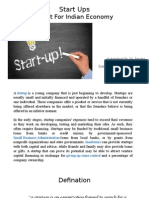Dr.
Komal Bodhwani
MODULE 2 - STARTUP FINANCE
2.1. Introduction to Start-Up Finance:
Start-up finance refers to the capital required to initiate and run a business until it becomes self-
sustainable. It includes funding for business registration, product development, marketing,
infrastructure, hiring employees, and day-to-day operational expenses.
Proper financial planning is necessary to ensure that a start-up can survive its initial phase, where
revenues may be low, and expenses may be high. Entrepreneurs must assess various sources of
finance, manage funds efficiently, and plan for future growth.
2. Types of Start-Up Costs
Start-up costs can be broadly classified into:
a) Fixed Costs (One-Time Expenses)
These are non-recurring costs necessary to start the business, including:
Business registration and licensing fees
Office or store setup costs
Equipment and machinery purchases
Initial marketing and branding expenses
Technology and software development
b) Variable Costs (Recurring Expenses)
These costs fluctuate based on business activities and include:
Raw material and inventory purchases
Employee salaries and wages
Rent and utilities
Advertising and promotion
Maintenance and administrative expenses
3. Sources of Start-Up Finance
Entrepreneurs can obtain funds from various sources depending on the business model, risk
appetite, and investment required. The main sources include:
a) Personal Savings
pg. 1
� Dr. Komal Bodhwani
Many start-ups begin with funds from personal savings. This is the safest option as there is no debt
or external interference, but it may not be sufficient for large-scale businesses.
b) Friends and Family
Borrowing from friends or family members is another common way to raise capital. It is usually
interest-free or has flexible repayment terms. However, it may lead to conflicts if not managed
properly.
c) Angel Investors
Angel investors are individuals who invest their personal funds in start-ups in exchange for equity
(ownership stake). They not only provide capital but also mentorship and industry connections.
d) Venture Capital (VC)
VC firms invest in start-ups with high growth potential in exchange for equity. They provide large-
scale funding but expect high returns and may influence business decisions.
e) Bank Loans
Traditional bank loans offer financial assistance based on creditworthiness and business plans.
These loans must be repaid with interest and require collateral in most cases.
f) Government Schemes and Grants
Governments often support start-ups through schemes like:
Startup India Initiative (India)
Mudra Loans for small businesses
SIDBI (Small Industries Development Bank of India) funding
These schemes offer low-interest loans, subsidies, and grants to promote entrepreneurship.
g) Crowdfunding
Platforms like Kickstarter, GoFundMe, and Indiegogo allow entrepreneurs to raise funds from a
large number of small investors. This is useful for innovative products and social enterprises.
h) Business Incubators and Accelerators
These organizations provide funding, mentorship, office space, and networking opportunities to
early-stage start-ups. Examples include Y Combinator and Techstars.
pg. 2
� Dr. Komal Bodhwani
4. Financial Planning and Budgeting
A well-structured financial plan is critical for managing start-up funds effectively. Key steps
include:
a) Estimating Capital Requirements
Determine initial costs and operational expenses
Set aside emergency funds for unexpected expenses
b) Creating a Budget
Categorize expenses into fixed and variable costs
Allocate funds efficiently to different business functions
c) Managing Cash Flow
Monitor cash inflows and outflows regularly
Maintain a positive cash flow to avoid liquidity issues
d) Break-Even Analysis
Calculate how much revenue is needed to cover costs
Helps in setting sales targets and pricing strategies
e) Profit and Loss Projection
Estimate revenues, expenses, and expected profits
Helps in securing investments and loans
5. Importance of Financial Management in Start-Ups
Effective financial management helps in:
Ensuring Business Survival: Proper fund allocation prevents financial crises.
Attracting Investors: A clear financial strategy increases credibility.
Optimizing Growth: Helps in scaling up operations and expanding the business.
Risk Management: Identifies financial risks and develops mitigation strategies.
6. Common Financial Challenges Faced by Start-Ups
Start-ups often struggle with:
pg. 3
� Dr. Komal Bodhwani
Lack of Funds: Difficulty in securing capital, leading to cash shortages.
High Burn Rate: Spending money too quickly without generating enough revenue.
Pricing Issues: Overpricing or underpricing products affecting profitability.
Debt Management: Balancing loan repayments while sustaining business operations.
To overcome these challenges, start-ups should focus on financial discipline, cost-cutting
strategies, and exploring multiple revenue streams.
7. Conclusion
Start-up finance is a crucial aspect of entrepreneurship, determining the success or failure of a new
venture. TYBMS students aspiring to start businesses must understand different financing options,
create financial plans, and effectively manage funds. Proper financial strategies ensure stability,
growth, and long-term sustainability in the competitive business world.
2.2 PITCH PRESENTATION:
Introduction to Pitch Presentation
A pitch presentation is a structured and persuasive communication used to present a business idea,
product, or service to potential investors, partners, customers, or stakeholders. The goal of a pitch
is to generate interest, secure funding, gain support, or establish partnerships.
A well-crafted pitch presentation should be clear, engaging, and backed by data. It must tell a
compelling story about the problem being solved, the solution provided, and why the proposed
idea is a valuable opportunity.
2. Types of Pitch Presentations
Different types of pitches are used depending on the audience and context. The main types include:
a) Elevator Pitch
A short and compelling speech (30-60 seconds) designed to capture interest quickly.
Used in networking events, quick investor meetings, or casual encounters.
b) Investor Pitch
A detailed presentation to potential investors, including financial projections, business
strategy, and expected returns.
pg. 4
� Dr. Komal Bodhwani
Typically presented in venture capital or angel investor meetings.
c) Sales Pitch
Focuses on persuading customers to buy a product or service.
Highlights benefits, unique selling points (USPs), and testimonials.
d) Startup Pitch (Pitch Deck)
A structured presentation used by start-ups to attract funding.
Usually includes slides on the problem, solution, market opportunity, business model, and
financials.
e) Product Pitch
Demonstrates a new product’s features, benefits, and use cases.
Often used during product launches, trade shows, or client meetings.
3. Key Elements of a Successful Pitch Presentation
A compelling pitch presentation typically includes the following elements:
a) Title Slide
Includes the company name, logo, and a catchy tagline.
Should create a strong first impression.
b) Problem Statement
Clearly defines the problem or gap in the market.
Uses real-world examples or statistics to establish urgency.
c) Solution
Explains how the product or service solves the problem.
Highlights the unique approach and competitive advantage.
d) Market Opportunity
Provides an overview of the target market, customer segments, and demand.
Includes market size, growth potential, and industry trends.
e) Business Model
pg. 5
� Dr. Komal Bodhwani
Describes how the company generates revenue.
Explains pricing strategy, revenue streams, and monetization methods.
f) Competitive Analysis
Identifies key competitors and their strengths/weaknesses.
Showcases how the company differentiates itself from competitors.
g) Go-to-Market Strategy
Outlines the plan for acquiring customers, scaling operations, and entering the market.
Includes marketing, sales, and distribution strategies.
h) Financial Projections
Presents estimated revenue, costs, and profit for the next 3-5 years.
Includes break-even analysis and return on investment (ROI).
i) Team
Introduces the core team members and their expertise.
Highlights key advisors or mentors.
j) Call to Action (CTA)
Specifies what is needed from the audience (e.g., funding, partnership, or sales).
Encourages next steps, such as scheduling follow-up meetings.
4. Steps to Create an Effective Pitch Presentation
To craft a compelling pitch, follow these steps:
Step 1: Research Your Audience
Understand the expectations, interests, and concerns of the target audience.
Customize the pitch to address their priorities and potential objections.
Step 2: Structure Your Presentation
Follow a logical flow from problem identification to solution and business potential.
Use storytelling techniques to make the pitch engaging.
Step 3: Keep It Simple and Visual
pg. 6
� Dr. Komal Bodhwani
Use minimal text and more visuals (charts, graphs, images).
Avoid jargon and technical complexities.
Step 4: Use Data and Evidence
Support claims with statistics, case studies, or testimonials.
Provide clear and realistic financial projections.
Step 5: Focus on Delivery
Maintain eye contact and use confident body language.
Practice multiple times to refine clarity and timing.
Step 6: Prepare for Questions
Anticipate potential investor or audience questions.
Have backup slides with additional data if needed.
5. Common Mistakes to Avoid in Pitch Presentations
Many pitch presentations fail due to common mistakes, such as:
a) Lack of Clarity
Overcomplicating the problem or solution without a clear message.
b) Too Much Information
Overloading slides with excessive text, numbers, or details.
c) Weak Financial Projections
Presenting unrealistic or vague financial estimates without data support.
d) Ignoring Competitors
Failing to acknowledge competition or differentiate the business effectively.
e) Poor Storytelling
Delivering a dull, fact-based pitch instead of using a compelling narrative.
f) Lack of Confidence
pg. 7
� Dr. Komal Bodhwani
Uncertain or nervous delivery reduces credibility.
g) No Clear Call to Action
Failing to specify the exact request (funding amount, partnership proposal, etc.).
6. Examples of Successful Pitch Presentations
Several well-known companies have secured funding through outstanding pitch presentations.
Some notable examples include:
a) Airbnb (2009 Pitch Deck)
Simple and visually appealing slides.
Clearly identified the problem ("Booking a hotel is expensive") and solution ("People can
rent out their spare rooms").
Focused on market potential and revenue model.
b) Uber (Early Investor Pitch)
Highlighted the inefficiencies in the taxi industry.
Explained how their ride-sharing model would disrupt the market.
Provided clear revenue projections and growth potential.
c) Facebook (Early Pitch)
Showed the growth of social networking.
Focused on user engagement and scalability.
Attracted investors with data-backed market potential.
These examples highlight the importance of simplicity, clarity, and data-driven storytelling in pitch
presentations.
7. Conclusion
A pitch presentation is a powerful tool for securing investment, customers, or partnerships.
Crafting a successful pitch requires clear messaging, strong data support, engaging storytelling,
and confident delivery. Entrepreneurs and business professionals must refine their pitches through
practice, feedback, and continuous improvement to maximize their chances of success.
pg. 8
� Dr. Komal Bodhwani
2.3 SOURCES OF FUNDING:
Introduction
Funding is the backbone of any business, whether it is a startup or an established company looking
to expand. Entrepreneurs must explore various sources of financing based on their business needs,
risk appetite, and repayment capability.
There are two primary categories of funding:
Equity Financing – Raising capital by selling ownership (shares) in the company.
Debt Financing – Borrowing money that must be repaid with interest.
Additionally, businesses can access hybrid funding options that combine elements of both equity
and debt financing.
2. Sources of Funding
A. Self-Funding (Bootstrapping)
Entrepreneurs use their personal savings or assets to fund the business.
This method retains full control of the company but has financial risks.
Suitable for small businesses or startups in the early stages.
B. Friends and Family
Borrowing funds from close relatives or friends.
Typically offers flexible repayment terms.
Risk of personal relationship strain if the business fails.
C. Angel Investors
High-net-worth individuals who provide capital to startups in exchange for equity.
Offer mentorship and networking opportunities.
Expect a high return on investment (ROI).
Examples: Ratan Tata (Tata Sons), Ron Conway, and Indian Angel Network.
D. Venture Capital (VC)
Professional investment firms that provide funding to high-growth startups.
Usually invested in exchange for equity and partial control over business decisions.
pg. 9
� Dr. Komal Bodhwani
Suitable for scalable businesses in tech, healthcare, and innovation-driven sectors.
Examples: Sequoia Capital, Accel Partners, Tiger Global.
E. Bank Loans
Traditional business loans from banks with fixed or variable interest rates.
Requires a strong credit history, collateral, and a solid business plan.
Common types:
o Term Loans – Lump sum amount repaid in fixed installments.
o Working Capital Loans – Short-term loans for daily operational expenses.
o SME Loans – Special loans for small and medium-sized enterprises.
F. Government Schemes and Grants
Government-backed funding options for startups and small businesses.
Often have lower interest rates or no repayment obligation (grants).
Examples in India:
o Startup India Scheme – Provides funding support to innovative startups.
o MUDRA Loans – Micro-financing for small businesses.
o SIDBI (Small Industries Development Bank of India) – Provides capital to
MSMEs.
G. Crowdfunding
Raising small amounts of money from a large number of people via online platforms.
Types of crowdfunding:
o Reward-Based – Investors receive non-monetary rewards (e.g., product samples).
o Equity-Based – Investors receive a share in the company.
o Donation-Based – No repayment or equity exchange; used for social causes.
Popular platforms: Kickstarter, Indiegogo, GoFundMe.
H. Business Incubators and Accelerators
Programs that provide mentorship, funding, office space, and networking for startups.
Incubators help startups in the early idea stage, while accelerators focus on growth.
Examples: Y Combinator, Techstars, T-Hub (India).
I. Corporate Sponsorship and Strategic Partnerships
Large companies invest in startups that align with their business interests.
Funding can come in the form of partnerships, joint ventures, or acquisitions.
Example: Google investing in AI startups to enhance its technology.
J. Initial Public Offering (IPO)
Raising capital by selling shares to the public through the stock market.
pg. 10
� Dr. Komal Bodhwani
Suitable for mature companies looking for large-scale funding.
Requires strong financial performance and regulatory compliance.
Examples: Zomato, Paytm, Nykaa IPOs in India.
3. Choosing the Right Source of Funding
Factors to consider when selecting a funding source:
✔ Stage of the Business – Early-stage startups may prefer angel investors, crowdfunding, or
incubators, while established businesses may opt for bank loans or IPOs.
✔ Risk Appetite – Entrepreneurs who do not want to dilute ownership may choose debt financing
over equity funding.
✔ Funding Amount Required – Small businesses may need government grants, while high-
growth startups require venture capital.
✔ Repayment Capability – Debt financing requires interest payments, whereas equity financing
involves sharing profits.
4. Conclusion
The right funding source depends on the nature, stage, and financial needs of the business.
Entrepreneurs must evaluate each option carefully to ensure sustainable growth while maintaining
financial stability.
2.4: STARTUP FINANCING THROUGH VENTURE CAPITAL FINANCING:
Introduction to Venture Capital Financing
Venture Capital (VC) financing is a form of private equity investment where venture capital firms
provide funds to high-potential startups in exchange for equity (ownership stake). This funding
helps startups scale operations, develop products, expand markets, and achieve long-term growth.
VC financing is particularly suited for startups with innovative ideas, high growth potential, and
scalable business models, especially in sectors like technology, healthcare, and fintech.
2. Characteristics of Venture Capital Financing
Equity-Based Investment: Investors receive shares in the company instead of loans.
High-Risk, High-Return: VC firms invest in startups with significant growth potential
but also high risk.
pg. 11
� Dr. Komal Bodhwani
Long-Term Investment: Investments typically last 5-10 years before the VC firm exits.
Active Involvement: VC firms provide mentorship, strategic guidance, and networking
opportunities.
Exit Strategies: Venture capitalists seek returns through IPOs, mergers, or acquisitions.
3. Stages of Venture Capital Financing
VC funding is provided in different stages, depending on the maturity and needs of the startup.
A. Pre-Seed Stage
Funding Source: Founders, angel investors, incubators, government grants.
Purpose: Market research, idea validation, initial development.
B. Seed Stage
Funding Source: Angel investors, early-stage VC firms.
Purpose: Product development, hiring key team members, initial customer acquisition.
Example: A startup raising ₹1-5 crore to build a prototype and test the market.
C. Series A Funding
Funding Source: VC firms, institutional investors.
Purpose: Expanding user base, refining business model, increasing revenue.
Example: A food delivery startup receiving ₹50 crore from a VC firm to scale operations.
D. Series B and C Funding
Funding Source: Large VC firms, private equity investors.
Purpose: Market expansion, new product development, entering international markets.
Example: A fintech company raising ₹200 crore to expand into new regions.
E. Growth/Expansion Stage (Series D and Beyond)
Funding Source: Late-stage VC firms, hedge funds, investment banks.
Purpose: Preparing for IPO, acquiring competitors, maximizing market dominance.
Example: A SaaS startup raising ₹500 crore before launching an IPO.
4. Venture Capital Investment Process
Step 1: Identifying Investment Opportunities
pg. 12
� Dr. Komal Bodhwani
VC firms evaluate startups based on business potential, market size, and competitive
advantage.
Step 2: Due Diligence
Investors analyze financials, business model, management team, and risk factors.
Step 3: Investment Agreement
Term sheets are signed, specifying valuation, equity distribution, and exit terms.
Step 4: Fund Disbursement
Funds are provided in tranches based on performance milestones.
Step 5: Monitoring and Growth Support
VC firms actively mentor startups, helping with strategy, hiring, and scaling.
Step 6: Exit Strategy
Investors exit through IPOs, acquisitions, or buybacks, realizing returns on investment.
5. Benefits of Venture Capital Financing
1. Access to Large Capital: Helps startups scale quickly.
2. Industry Expertise & Mentorship: VCs provide strategic guidance.
3. Networking & Partnerships: Opens doors to new clients, investors, and talent.
4. No Immediate Repayment: Unlike loans, VC funding does not require monthly
repayments.
6. Challenges & Risks of VC Financing
❌Equity Dilution: Founders lose partial ownership and control.
❌High Expectations: VCs demand rapid growth and profitability.
❌ Pressure to Exit: Startups must plan for IPOs or acquisitions to provide investor returns.
❌ Selective Investment: Only a small percentage of startups secure VC funding.
pg. 13
� Dr. Komal Bodhwani
7. Successful Startups Funded by Venture Capital
India:
Flipkart – Raised VC funding from Tiger Global, Accel Partners, later acquired by
Walmart.
Zomato – Backed by Info Edge, Sequoia Capital; later launched an IPO.
Paytm – Received investments from SoftBank, Alibaba before IPO.
Global:
Facebook – Early investment from Accel Partners.
Airbnb – Funded by Sequoia Capital and Andreessen Horowitz.
Uber – Raised billions from VC firms before going public.
8. Conclusion
Venture Capital financing is a crucial funding source for startups with high growth potential. While
it provides substantial capital and expertise, founders must carefully consider equity dilution and
investor expectations before opting for VC funding.
pg. 14
� Dr. Komal Bodhwani
2.5: INNOVATIVE WAYS TO FINANCE A STARTUP:
Introduction
Financing a startup is one of the biggest challenges entrepreneurs face. While traditional funding
sources like bank loans and venture capital are common, innovative financing methods can provide
alternative solutions, especially for early-stage startups with unique business models.
These creative funding options allow startups to raise capital while maintaining flexibility,
reducing risk, and sometimes even avoiding debt.
2. Innovative Startup Financing Methods
A. Crowdfunding
What it is: Raising small amounts of money from a large number of people through online
platforms.
Types of Crowdfunding:
o Reward-Based: Backers receive non-monetary rewards (e.g., early product
access).
o Equity-Based: Investors receive shares in the startup.
o Donation-Based: People contribute money without expecting returns.
o Debt-Based (P2P Lending): Backers provide loans to be repaid with interest.
Platforms: Kickstarter, Indiegogo, GoFundMe, Crowdcube.
Example: Pebble Smartwatch raised over $10 million on Kickstarter.
B. Revenue-Based Financing (RBF)
What it is: Startups receive funding in exchange for a percentage of future revenue until a
fixed return is met.
Best for: SaaS companies, e-commerce businesses with predictable revenue.
Advantages: No equity dilution, repayments scale with business growth.
Example: Clearco provides RBF to startups based on real-time revenue analytics.
C. Corporate Partnerships & Sponsorships
What it is: Large companies invest in startups that align with their business goals.
pg. 15
� Dr. Komal Bodhwani
Best for: Startups offering complementary products or innovations in corporate sectors.
Advantages: Provides funding, market access, and credibility.
Example: Google invests in AI startups to enhance its technological ecosystem.
D. Startup Competitions & Grants
What it is: Startups compete for funding through business pitch competitions or apply for
government/NGO grants.
Best for: Innovative, research-based, or social impact startups.
Advantages: No repayment, no equity loss.
Examples:
o Hult Prize: Social entrepreneurship competition.
o NASSCOM 10,000 Startups (India): Offers grants and support to tech startups.
o Startup India Seed Fund Scheme (India): Grants for early-stage startups.
E. Initial Coin Offering (ICO) & Tokenization
What it is: Startups raise funds by issuing digital tokens or cryptocurrencies.
Best for: Blockchain, fintech, and decentralized finance (DeFi) startups.
Advantages: Global investor access, no need for traditional financial institutions.
Example: Ethereum raised funding through an ICO before launching its blockchain.
F. Bootstrapping with Pre-Sales
What it is: Selling products before production to raise funds.
Best for: Hardware startups, SaaS, and e-commerce businesses.
Advantages: No equity dilution, funds come directly from customers.
Example: Tesla pre-sold Cybertrucks before manufacturing to generate capital.
G. Venture Debt
What it is: Startups borrow money from specialized lenders or funds instead of giving up
equity.
Best for: Startups with VC backing but needing extra capital.
Example: Indian startups like OYO and Swiggy have used venture debt for expansion.
pg. 16
� Dr. Komal Bodhwani
H. Microfinance & Peer-to-Peer (P2P) Lending
What it is: Small loans from non-bank institutions or individuals.
Best for: Early-stage startups and social enterprises.
Platforms: LendingClub, Faircent (India).
I. Royalty-Based Financing
What it is: Investors fund the startup in exchange for a percentage of future sales instead
of equity.
Best for: Startups in entertainment, consumer products, and intellectual property sectors.
Example: Musicians and authors use this to finance new projects.
J. Community Investment & Local Support
What it is: Raising funds from local communities, organizations, or impact investors.
Best for: Social enterprises, small businesses with strong community ties.
Example: Local bakeries or craft businesses securing funds from loyal customers.
3. Conclusion
Innovative financing methods provide startups with flexible and creative ways to raise capital
without traditional loans or equity dilution. Choosing the right funding option depends on the
startup’s industry, growth stage, and financial needs.
pg. 17










































































































